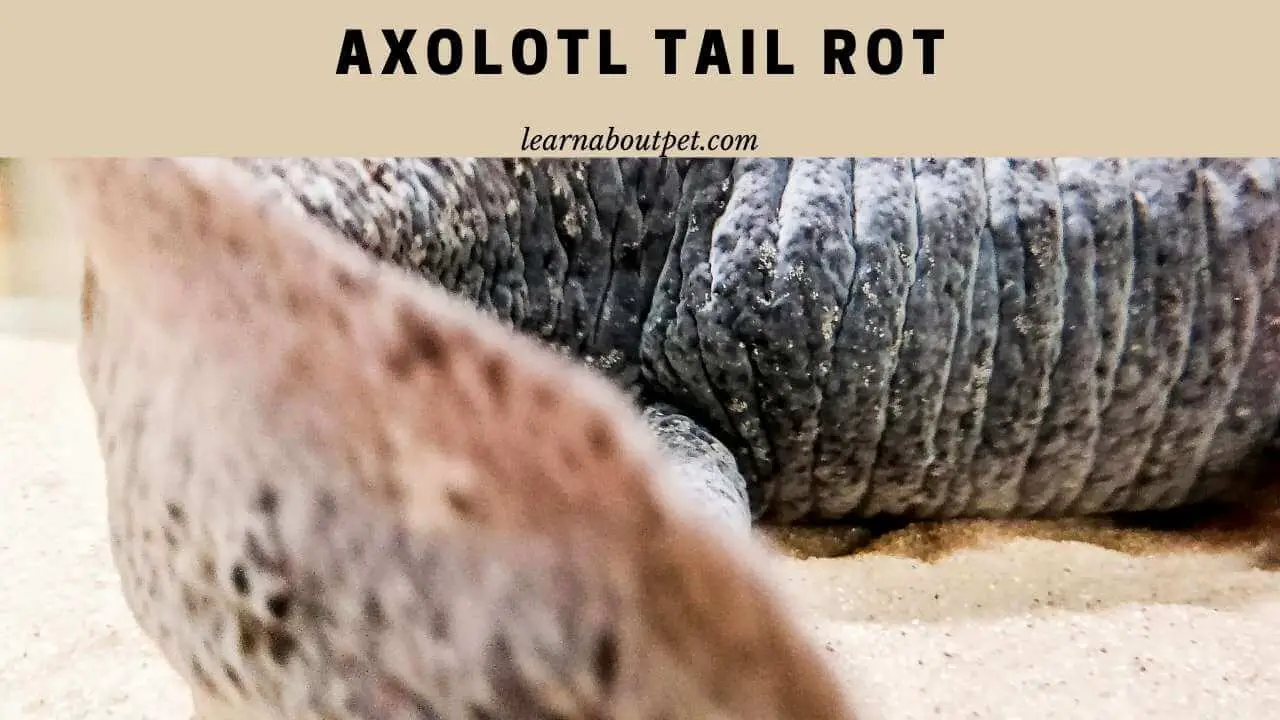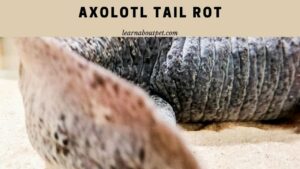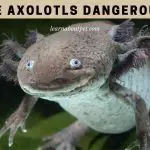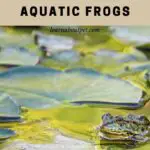Every pet owner wants to have a healthy pet without any problems. If you are caring for an aquatic pet such as an axolotl, there is a lot to consider so that they can become long-lived pets in your aquarium. One thing that many owners still don’t know about is the axolotl tail decay.
What makes an axolotl tail rot? Axolotls can be affected by either fungal, infectious, or both. If the condition worsens, it can spread to other body parts such as the gills and arms. Immediately take the axolotl to the vet to check the condition of the axolotl if it is exposed to a severe infection or fungus.
Since this can shorten the life expectancy of the axolotl, you should know everything about the tail rot. Let’s find out in this article.

What Is Wrong With My Axolotl’s Tail?
If you see your axolotl’s tail rotting away and disappearing, there is something wrong with their health. It started with the red color is on the axolotl tail, then it got darker, and the tail started to disappear little by little.
If you leave it, the situation will get worse and spread to the gills or skin, and experience the same thing as disappearing. Even though the axolotl can regenerate, if the rot problem is not addressed, it may lose its ability to regenerate quickly and become a rotting problem.
Many factors allow this to happen, such as the axolotl being stressed, the axolotl being in a tank with poor water conditions, being too crowded for a tank with much small fish, and one axolotl, or some other problem.
It is also possible that there is a fungus on the axolotl’s body originating from their tail. If it is left untreated, the fungus will grow and make axolotl tail rot. Don’t take this for granted, as axolotls can become less and less likely to eat, and their condition will slowly worsen.
Why Is My Axolotls Tail Damaged?
Many things can make an axolotl’s tail damaged because of their own actions. For example, if the axolotl moves too fast while swimming, their tail can be injured by sharp edges from silk plants, places when they can hide, or sharp edges around the tank.
If your axolotl only receives an injury, it will recover in a short time. However, if the axolotl’s tail becomes infected, the wound will be difficult to heal and may develop axolotl tail rot symptoms.
This is different from axolotl pink tail because they are exposed to certain fungi or bacteria because if their tail is injured, long red streaks will appear, not just at one particular point.
The stressed axolotl tail is also different from the two and is more likely to be red all over and sometimes curled, indicating inappropriate water parameters or poor body condition.
Both injury, infection, fungi, or stress can make the axolotl’s tail damaged, although the severity of the damage will vary.
Should I Be Worried About Axolotl Tail Damage?
If the axolotl has had a tail damaged problem for a long time and it doesn’t heal, then you should worry about it.
The axolotl has a regeneration system in its body that can heal or even regrow lost body parts. But this can be hampered by severe infection or due to a fungus that stops the regeneration process.
When you see an axolotl white lips and curled tail, but their tail doesn’t show any signs of damage, that’s a different matter.
Axolotls that are paler in color with curled tails are a sign that they are not comfortable in bad water conditions. Axolotls will also float because they feel uncomfortable being in a tank with dirty water.
Whether the axolotl is sick or has a problem with the tail, you should still worry about their condition because they can worsen. A healthy axolotl will not show any symptoms, and they will be responsive to their surroundings, swim to and fro, and have a high appetite.
How Do I Know If My Axolotl Has Fungus?
The fungus has the shape of cotton-like tufts, is fluffy, and can be seen immediately by you. Usually, the fungus is at the point of injury or in the gills. Fungal attacks are also common on the axolotl’s legs or arms and can make these body parts rot if left untreated.
When you look at the fungus through a microscope, it will look like branches forming a central mass. The fungus can degenerate the affected part, and the body part will be slimy and cloudy.
Because axolotl tail rot can also be caused by a fungus, check their tail for a white, cotton-like color on the tail and stick to anywhere when the axolotl is active. You can check clearly if the axolotl floating tail up and see if the tail point has a lot of fungal infection or not.
How Do You Treat Axolotl Bacterial Infection?
Several things can be done if your axolotl is exposed to an axolotl tail rot due to bacterial infection by using antiseptics, antibiotics, and salt baths. Many axolotl owners prefer to do a salt bath on their pets because it is effective for treating any infection.
Fungal infection can also stress the axolotl because if there is still a little fungus attached to the axolotl’s body, it can come right back or spread more severely.
If you feel overwhelmed by this, you can immediately ask the vet for advice to be given antibiotics or antiseptics so that the bacteria will immediately disappear from the axolotl’s body.
Signs if you have to immediately deal with the tail part of the axolotl if they do axolotl tail floating, and do it continuously for some time. It is better to take treatment as soon as possible to reduce the risk of a more severe infection occurring.

Why Is My Axolotl Tail Red?
If you see a red axolotl tail and the skin or their feet are also red, this is due to a bacteria called “red leg.” These bacteria will make some parts of the axolotl’s skin or body red, inflamed, and irritated. The axolotl also looks like it wants to scratch the red spot.
Axolotl red tail can also be seen if they have less pigment so that their blood vessels are clearly visible even beneath the skin. This is nothing to worry about because it normally happens the lower the pigment.
If axolotls don’t have less pigment, then why is my axolotls tail red? There is another possibility of the axolotl’s tail getting injured. If the wound is exposed to bacteria and becomes infected, it can get axolotl tail rot.
Antiseptics or antibiotics can relieve symptoms of infection that arise from the wound spot if treated quickly. Don’t wait too long if you see an axolotl tail turning into red, and find out why.
Why Is My Axolotls Tail Curled?
The axolotl tail curled is the most obvious sign when the axolotl is under stress. Axolotls can be stressed by many things, including water conditions, tank mates, or hunger.
Many axolotl owners are beginners who don’t really pay attention to water conditions, such as how often to change the water, the right temperature for the axolotl tank and checking the water for ammonia nitrites and nitrates levels.
Although sometimes not curled, the axolotl tail wavy also indicates that the axolotl is stressed. Another thing that can make an axolotl like that is the heavy flow of tanks because axolotls only want to live in calm water.
Although it is not one of the axolotl tail rot problems, this must also be considered because stressed axolotls will affect their health.
What Is The Reason Behind Axolotl Curled Tail?
Since we know that the curled tail axolotl is caused by stress, we also need to know what can cause the axolotl to stress.
Signs of axolotl’s health or not can be seen from the axolotl tails, so we also have to know what factors can make them uncomfortable. The table below shows some of the factors that can create a curled tail axolotl.
| Cause of stress | Explanation |
| Bad water parameters | The ammonia or nitrites level is too high, so the axolotl is not comfortable in the tank. |
| Aggressive tank mates | Larger axolotls or large, aggressive fish can stress the axolotl by feeling intimidated. |
| Overcrowded | Axolotls prefer to live alone in tanks without having many small fish also in the same place. |
| Strong water flow | Strong current makes axolotl not free to move and easy to stress. |
How Lizards Regenerate Their Tails?
Lizards will regenerate their tails only when they are detached from their bodies. For axolotls, not only tails but feet, gills, and other organs can grow back because of their regeneration ability.
The cell will grow new tissue, and from that tissue will form a new tail. If you experience an axolotl tail rot problem, this will affect their regeneration process because certain fungi or bacteria can suppress the lizard tail regeneration mechanism.
Fungal or bacteria must first be removed from the body of the axolotl so that the regeneration process can return to function.
How Many Times Can A Lizard Regrow Its Tail?
Lizards can regrow their tail as many times as they need, although sometimes there are some lizards that can no longer regrow their tailback after losing them several times. Lizards can take up to 60 days before their tails function normally.
If the lizard loses its tail again before returning to normal, then the next regeneration process will be hampered because it has to go back to the process again.
For example, if an axolotl tail ripped, it can regrow multiple times if the same problem occurs, unless their tail is exposed to a fungus or infection that causes degeneration or axolotl tail rot.
Do Axolotls Tails Grow Back?
The axolotl is a salamander that has the highest regeneration rate compared to others. Axolotl tail regeneration can be faster when compared to lizards, around 40 to 50 days. 10-20 days difference from the lizards to reactivate the newly grown tail.
Not only the tail, but limbs, arms, legs, and brain can also be regrown by axolotl. This makes the researchers want to examine the axolotl more deeply about its great regeneration ability.
Axolotl Tail Regeneration Histology
The axolotl’s ability to regenerate is quite extreme because they can grow back their body parts or lost organs and be activated immediately like new without any scars left behind.
The axolotl creates new body organs or body parts as if nothing ever happened to the axolotl. Figuring out the regeneration process from axolotl to microscopic to see the tissue is very interesting and has been carried out until now by researchers.
If you look at the axolotl tail rot pictures and you can treat the axolotl tail rot until the infection or bacteria is gone from their body, you can also monitor the axolotl’s regeneration process for the next 40-50 days.
Final Verdict – Axolotl Tail Rot
If you have some parts of the axolotl’s body rotting and start to fall slowly, then you should find out the point of the problem by consulting a vet. If your vet gives antibiotics or antiseptics to your axolotl, make sure you also find out the main cause of their tail is rotting.

If it is due to fungal, bacterial, or infection, this can cause severe axolotl condition because the axolotl’s ability to regenerate can also be hampered. When looking at tail rot, you can do a fridging or salt bath for the process of removing bacteria.
If your axolotl is curled or wavy, the axolotl is probably stressed. Ensure several things such as the temperature in the tank, ammonia and nitrates level, and water current according to the axolotl’s needs so that they are not easily stressed and exposed to diseases.

Welcome to Learn About Pet. My name is Rajkumar Ravichandran and I love all pets, travel, and amazing food. I write about my passion and personal experience caring for multiple pets in this blog! ❤️
Post Disclaimer
DISCLAIMER: THIS BLOG OR WEBSITE, "Learn About Pet", DOES NOT PROVIDE YOU WITH MEDICAL ADVICE AND IS NOT A SUBSTITUTE FOR MEDICAL ADVICE. ALWAYS GET IN TOUCH WITH YOUR PERSONAL VETERINARIAN AND USE INFORMATION HERE AS GENERAL ADVICE.
The information, including but not limited to, text, graphics, images and other material contained on this website are for informational purposes only. No material on this site is intended to be a substitute for professional veterinary advice, food recommendation, diagnosis, or treatment. Always seek the advice of your veterinarian or other qualified health care provider with any questions you may have regarding a medical condition or for pet food related questions.







